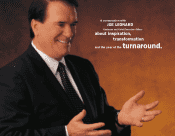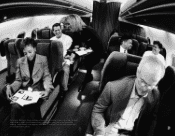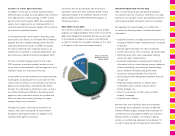Airtran 1999 Annual Report Download - page 4
Download and view the complete annual report
Please find page 4 of the 1999 Airtran annual report below. You can navigate through the pages in the report by either clicking on the pages listed below, or by using the keyword search tool below to find specific information within the annual report.
How would you describe the company’s
performance last year?
To put it simply, 1999 was an amazing year for our
company. It marked an unequivocal turnaround in
operational and financial health. Our plans to reduce
costs, boost revenues and sustain profitability were
tremendously successful. Our strategies not only
produced solid results last year, they created a
strong foundation upon which we will build even
greater value for our employees, our customers
and our shareholders for years to come.
What were the key financial results of
the turnaround?
For starters, AirTran Airways, Inc., produced operating
profits in each quarter of 1999. Excluding a non-cash
fleet disposition charge and the gain from a litigation
settlement, we generated net earnings for the year of
$29.1 million on operating revenues of $523.5 million,
up 19.2 percent from 1998. AirTran Airways ended
the year with $76.2 million in cash, an improvement
of $51.8 million from the end of 1998.
And, how about traffic?
We attracted greater passenger traffic without sacrificing
yield. In fact, yield increased 8.0 percent over 1998.
Our revenue per available seat mile (RASM) rose 15.1
percent, higher than any major airline in the industry,
while operating cost per available seat mile rose only
3.5 percent. And, we did all this in the face of fierce
competition, higher fuel prices, Hurricane Floyd and a
variety of other challenges.
What did the company do to get such
positive results?
By focusing on our established routes from our Atlanta
hub last year, we were able to achieve all-time record
traffic, capacity and passenger enplanements. Load
factor for 1999 rose to 63.5 percent, an increase
of 3.9 points over 1998. That’s a 7.1 percent gain
in revenue passenger miles (RPMs), to 3.5 billion RPMs,
on 0.5 percent more capacity, or 5.5 billion available
seat miles (ASMs). More than 6.4 million passengers
flew with us in 1999, up from 5.5 million in 1998.
By virtually any measure, our 1999 numbers are solid.
But the impression from 1999 that will endure, that
best signified the company’s turnaround, was that of
AirTran Airways’ first Boeing 717-200 touching down at
Hartsfield Atlanta International Airport on the 24th of
September. After years of anticipation, that new aircraft
and the 49 Boeing 717s that follow, embody AirTran
Airways’ transformation into an airline of the future.
How does the Boeing 717 benefit the company?
As the most passenger-friendly aircraft in its class,
the Boeing 717 will add dramatic operating efficiencies
to our already low cost structure. Despite impressive
power, its engines burn as much as 23 percent less
fuel per hour than the DC-9. With up to 60 percent
fewer parts in its environmental, avionics and electrical
systems, the Boeing 717 will also significantly lower
our fleet’s maintenance and inventory costs. The new
aircraft should reduce our overall seat-mile costs.
How did the company finance the new aircraft?
First, let me say that our Boeing 717 financing marks
our successful re-entry into the capital markets since
1997 and demonstrates that the financial community
believes in AirTran Airways’ turnaround. We financed our
first ten Boeing 717s with proceeds from the private
placement of $178.9 million aggregate principal amount
of enhanced equipment trust certificates (EETCs).
As part of our fleet disposition strategy, we have also
sold a total of thirteen DC-9-30 aircraft in 1999. AirTran
Airways will continue to operate seven of those DC-9s
through lease financing arrangements. We will continue
to retire our older aircraft, as conditions dictate, while
we bring more Boeing 717s into service — eight
new 717s are expected in 2000, sixteen in 2001,
and eighteen in 2002. At that point, we will have one
of the youngest jet fleets in the nation.
In addition to Boeing 717s, what else contributed
to the operational and financial turnaround?
Throughout 1999, we accomplished several other key
strategic goals outlined at the beginning of last year.
We strengthened our hub operations at Hartsfield Atlanta
International Airport in September by restructuring
our connecting banks. Recently, we also increased the
number of AirTran Airways’ gates from 18 to 22. We
improved customer-service training by implementing
an extensive and ongoing program aimed at further
developing an environment of Caring Customer Service.
And we expanded our route system to serve Newark and
the new Beau Rivage Resort in Gulfport/Biloxi, entering
only those markets that offered attractive returns.
But, the biggest reason for our tremendous success
in 1999 is our people. We have nearly 4,000 of the
most dedicated and enthusiastic employees in the
industry. Without them, we could not have achieved
our extraordinary turnaround.
What does the future hold for the company?
We have a simple long-term vision for our success.
We will strive to grow by being an industry leader.
After all, the world doesn’t need another ordinary
airline. But, millions of people will value an airline
that changes things for the better. That means
constantly working to be the best in safety, technology
and Caring Customer Service.
We achieved things in 1999 few people thought possible.
Our leadership team and employees are ready and eager
to continue the good fight and make more airline history
in 2000.

















